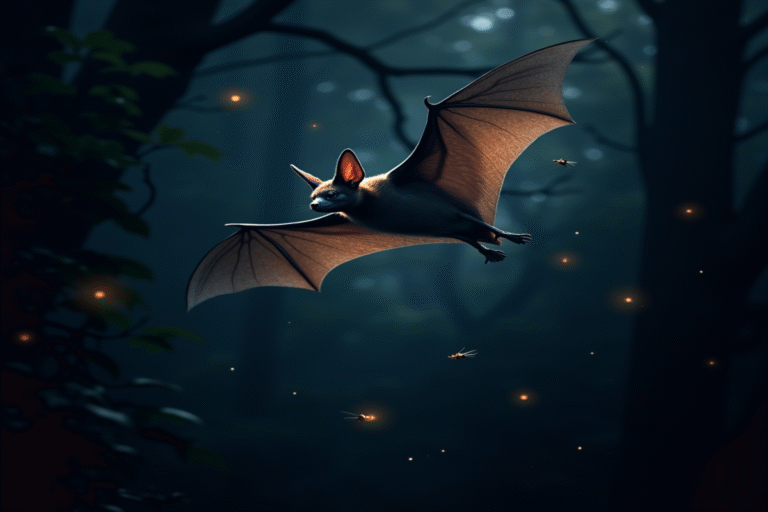Imagine flying at high speeds through complete darkness, dodging obstacles, and hunting tiny insects with remarkable precision—all without using your eyes. This extraordinary ability is routine for bats, thanks to their sophisticated echolocation system, a biological sonar that transforms sound waves into a detailed mental map of their surroundings.
The Basics of Bat Echolocation
Bats evolved echolocation around 50 million years ago, developing one of nature’s most advanced sensory systems. While hunting or navigating, a bat emits ultra-high-frequency sound pulses—typically between 20,000 and 200,000 Hz, well beyond the human hearing range (which tops out around 20,000 Hz). These sound waves travel through the air, bounce off objects, and return to the bat as echoes.
What makes this truly extraordinary is how bats process these returning echoes. Their brains create detailed three-dimensional maps of their surroundings based solely on sound reflections, allowing them to detect objects as thin as a human hair in complete darkness.
The Incredible Mechanics
The mechanics behind echolocation are fascinating:
- Sound production: Depending on the species, bats produce sounds through their larynx (voice box) or by clicking their tongues. Some bats can produce up to 200 sound pulses per second when closing in on prey.
- Specialized ears: Bat ears contain specialized structures that can detect tiny time differences between sounds reaching each ear—as little as 0.000003 seconds—allowing them to pinpoint the exact location of objects.
- Brain processing: Almost one-third of a bat’s brain is dedicated to processing acoustic information, compared to about 8% of the human brain devoted to vision.
Adjustable Frequencies for Different Tasks
Perhaps most impressive is how bats adjust their echolocation calls for different situations. When searching for prey in open areas, they emit lower-frequency calls that travel farther. Once prey is detected, they switch to higher-frequency sounds that provide more detailed information but over shorter distances—a technique called the “feeding buzz.”
This frequency modulation allows bats to create different types of “images” based on their needs—from broad overviews of their environment to highly detailed close-ups of potential prey.
The Doppler Effect Master
Horseshoe bats have evolved an exceptional adaptation: they can compensate for the Doppler effect (the change in frequency caused by movement). As they fly toward an object, the returning echoes would normally increase in frequency, potentially confusing the bat. However, these bats automatically lower their outgoing call frequency to compensate, keeping the returning echoes at a consistent, easily interpretable frequency—essentially performing complex physics calculations in real-time.
Jamming Avoidance and Social Coordination
When multiple bats fly together, they face the challenge of separating their own echoes from those of other bats. To solve this problem, many bat species can shift their call frequencies to create unique “acoustic signatures.” Some even take turns calling when flying in groups—a sophisticated form of social coordination that prevents echolocation jamming.
Echolocation Versus Vision
Contrary to popular belief, most bats are not blind—they have functional eyes and can see reasonably well. However, echolocation provides advantages that vision cannot:
- Works in complete darkness
- Reveals textures and densities of objects, not just their outlines
- Can detect prey hiding behind obstacles
- Provides precise distance information
The most advanced bat echolocation systems can detect insects as small as mosquitoes from over 16 feet away, distinguish between different insect species based on their wing-beat patterns, and navigate through forests with thousands of obstacles without collision—all while flying at speeds up to 60 mph.
Inspiring Human Technology
The precision of bat echolocation has inspired many human technologies, from naval sonar systems to assistive devices for the visually impaired. Scientists have even developed algorithms based on bat echolocation to improve medical ultrasound imaging and autonomous vehicle navigation systems.
Perhaps most remarkable of all: bats perform these complex acoustic feats with a brain the size of a peanut, processing vast amounts of data in milliseconds—a humbling example of nature’s engineering skill that continues to astonish scientists and inspire technological innovation.





